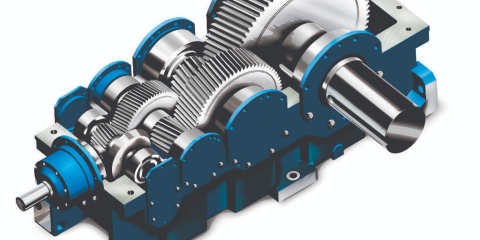Gearbox insights unlocked: real-time Mesh Stiffness Estimation

In the world of industrial machinery, gearboxes play a pivotal role in transmitting power across a wide range of applications. Despite their robustness, gearboxes are susceptible to wear and damage due to harsh operating conditions, high service loads and prolonged use. Thus, the early detection and diagnosis of faults is crucial to prevent significant economic losses or potential catastrophes due to sudden failure of transmission components.
Traditional condition monitoring methods have primarily relied on analysing vibrations to indirectly assess the state of gear meshing and predict the health status of the transmission. However, correctly interpreting the vibration signals – which are influenced by the operating conditions and the gearbox's design – can be complex. In contrast, the latest advancements in gearbox diagnostics employ a more direct and efficient approach by utilizing encoder measurements positioned closer to the meshing gears in order to accurately monitor the mesh stiffness in real time. Real-time mesh stiffness estimation has proven to be a robust parameter that indicates the health of the gearbox and remains consistent across different operational conditions.
How does mesh stiffness estimation work?
This approach combines a physics-based gear model with rotational position data collected from encoders mounted on the gear shafts. This method not only simplifies the path between the source of gear meshing and its measurement but also enhances the accuracy of diagnostics. The cornerstone is the augmented extended Kalman filter, a sophisticated algorithm designed to process the encoder data. By updating its estimates in the angle domain immediately following an encoder pulse, the Kalman filter can accurately adjust its predictions of mesh stiffness and the overall health of the gearbox.

Experimental Validation
The practical application of this method has been validated in a test setup at the University of South Wales (UNSW). Their experiment used a single spur gear pair with a root crack of different sizes and has proven the method's effectiveness in estimating mesh stiffness variation under different loads and speeds. The ability to detect a significant reduction in mesh stiffness near a damaged tooth exemplifies the method's precision and potential for enhancing gearbox reliability.
Depicted below is the set-up of the experiment. The graph shows how the cracked tooth stands out prominently in the results. The ability of this method to detect a significant reduction in mesh stiffness near a damaged tooth exemplifies the method's precision and potential for enhancing gearbox reliability.

Future of condition monitoring and remaining useful life prediction
By leveraging direct measurement techniques and advanced filtering algorithms, real-time monitoring of mesh stiffness represents a significant leap forward in condition monitoring methods, setting a new standard for industrial maintenance practices. It offers invaluable insights into the gearbox's performance, allowing for the early identification of potential issues. By integrating these observations with advanced classification methods and predictive maintenance models, it is possible to address faults proactively, thereby minimizing downtime and maximizing operational efficiency. It provides a robust tool for improving the reliability, efficiency, and performance of geared transmissions. This ultimately leads to lower energy consumption, cost savings and improved customer satisfaction.
What does this mean for you?
Flanders Make has been doing intensive research in the field of condition-based maintenance for years and will keep up with the latest advancements in technology. We developed several software toolboxes for component defect detection and have a number of test rigs with which we test hardware and software.
We can guide companies towards the appropriate methodology and technology for their condition-based maintenance.
